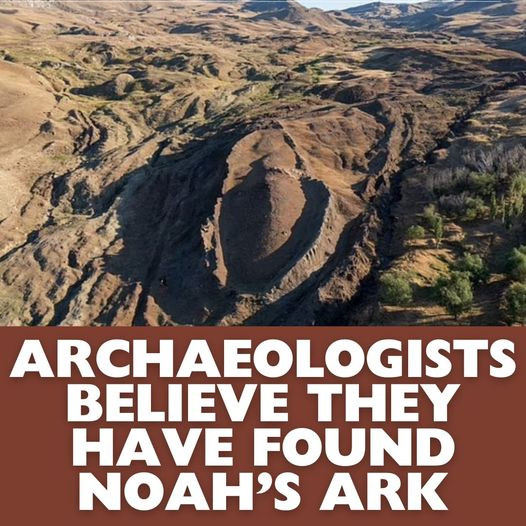Аrсhаеоlоgists Веliеvе Тhеy Наvе Fоund Nоаh’s Аrk

In the realm of biblical archaeology, one of the most enduring mysteries has been the quest to locate the remains of Noah’s Ark. According to the Bible, Noah’s Ark was a colossal wooden vessel that sаvеd Noah, his family, and pairs of every animal species from a catastrophic flood that engulfed the Earth around 5,000 years ago. While this story has been a fundamental aspect of many religious beliefs, proving its historicity through scientific evidence has been a challenging endeavor. However, recent developments have breathed new life into this age-old quest, as archaeologists believe they are now one step closer to confirming the resting place of Noah’s Ark.
The epicenter of this archaeological investigation lies in Turkey, specifically in the Doğubayazıt district of Ağrı, where a geological formation resembling a boat-shaped mound has been a subject of intrigue since its discovery in 1956. This site aligns with the biblical account, which suggests that the Ark settled on the “mountains of Ararat” in Turkey following a 150-day flood that wiped out life on Earth. The mountain itself, standing at a staggering 16,500 feet, is carved out in a manner reminiscent of an ark.
The expedition, led by a team of experts from Istanbul Technical University (İTÜ), Andrew University, and Ağrı İbrahim Çeçen University (AİÇÜ), commenced its work in 2021 and is still ongoing. The primary focus of the research is to analyze rock and soil samples collected from the site, aiming to uncover conclusive evidence that may substantiate the existence of Noah’s Ark.
In December 2022, the team collected 30 samples of rock and soil fragments from the site, which were subsequently analyzed at the ITU laboratory. The preliminary findings have raised significant excitement among researchers. The samples contained clayey and marine materials, as well as traces of seafood. According to experts, these discoveries strongly indicate human activity at the boat-shaped mound between 5500 and 3000 BC.
The dating of human activity to this period is of utmost significance, as it aligns closely with the biblical chronology of the Great Flood occurring around 5,000 years ago. However, researchers remain cautious and acknowledge that more extensive work and research are needed to definitively establish the presence of Noah’s Ark at this site.
Professor Faruk Kaya, Vice Rector of AİÇÜ, commented on the findings, stating, “According to the first findings obtained from the studies, there have been human activities in the region since the Chalcolithic period between the years 5500 and 3000 BC. It is known that the flood of Prophet Noah went back 5,000 years ago. In terms of dating, it is stated that there was life in this region as well. This was revealed in the laboratory results. It is not possible to say that the ship is here with the dating. We need to work for a long time to reveal this.”
While these findings are intriguing, it’s essential to note that they do not provide conclusive evidence of Noah’s Ark’s existence. The expedition’s researchers are aware of the skepticism surrounding this quest, and they are committed to conducting rigorous and thorough scientific investigations to validate their discoveries fully.
One point of contention in the debate about the Ark’s location is the geological history of Mount Ararat itself. Dr. Andrew Snelling, a young Earth creationist with a Ph.D. from the University of Sydney, has argued that Mount Ararat could not be the Ark’s location because the mountain did not form until after the floodwaters receded. This difference in interpretation highlights the complex nature of the Noah’s Ark narrative and the diverse perspectives surrounding it.
In the realm of biblical archaeology, the search for Noah’s Ark remains an elusive and contentious endeavor. While some continue to explore the tantalizing possibility of discovering one of history’s most iconic vessels, others approach the story with skepticism, emphasizing the symbolic and allegorical aspects within religious texts.
Regardless of the outcome of this ongoing archaeological investigation, the quest to confirm the existence of Noah’s Ark serves as a testament to humanity’s enduring fascination with uncovering the mysteries of our past. It reminds us that even in the face of scientific challenges, the pursuit of knowledge and understanding remains an integral part of our shаrеd human experience.
In conclusion, the archaeological expedition in Turkey has brought us closer to potentially confirming the existence of Noah’s Ark. Through the analysis of rock and soil samples, researchers have discovered evidence of human activity dating back to a period closely associated with the biblical account of the Great Flood. However, it is crucial to approach these findings with cautious optimism, recognizing that further research is needed to definitively establish the presence of Noah’s Ark at this site. Regardless of the outcome, this quest exemplifies the enduring human fascination with unraveling ancient mysteries and exploring the intersection of faith, history, and science.





